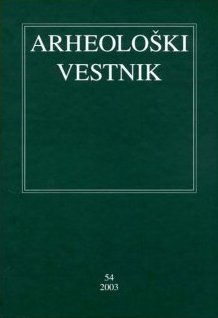Palaeolithic flutes: Divje babe I, Istállóskő, Lokve etc. Viewpoints of experts and their adversaries
Critical survey of the “Archaeological appraisal of the Divje babe I specimen No652”,and arguments to defend the specimens PB51/20 and Pb606 of the HNM Budapest
Povzetek
V članku sta na objektiven način obravnavani domnevnioziroma verjetni “piščali” iz jam Divje babe I in Istállóskő,skupaj z drugimi “možnimi piščalmi”. Zavrnjene so absolutnogotove trditve nasprotnikov domnevnih piščali. Prikazane sonjihove napake in tendenciozne tabele. Na področju domnevnegaso samo različne možnosti in subjektivna mnenja, tako da jearheologija prisiljena živeti z iluzijami.
Prenosi
Literatura
ABSOLON, C. 1936, Les f lûtes paléolithiques de l’Aurignicienet du Magdalénien de Moravie (Analyse musicale etethnologique comparative, avec démonstrations). - Dans: Congrès Préhistorique de France Session XII, 770-784.
ALBRECHT, G., C.-S. HOLDERMANN, T. KERIG, J. LECHTERBECK et J. SERANGELI 1998, “Flöten” ausBärenknochen - die frühesten Musikinstrumente? - Arch. Korrbl. 28/1, 1-19.
ALBRECHT, G., C.-S. HOLDERMANN et J. SERANGELI2001, Towards an archaeological appraisal of specimen N°652 from Middle-Palaeolitihic level D / (layer 8) of the Divjebabe I. - Arh. vest. 52, 11-15.
BRADE, C. 1975, Die mittelalterlichen Kernspaltflöten Mittel-und Nordeuropas. Ein Beitrag zur Überlieferung prähistorischerund zur Typologie mittelalterlicher Kernspaltflöten. - GöttingerSchriften zur Vor-und Fühgeschichte 14.
BRODAR, M.1985, Fossile Knochendurchlochungen. - Razpr. 4. razr. SAZU 26, 29-47.
BRODAR, M. 1999, Die Kultur aus der Höhle Divje babe I. -Arh. vest. 50, 9-57.
BRODAR, S. et M. BRODAR 1983, Potočka zijalka. Visokogorskapostaja aurignacienskih lovcev (Potočka zijalka. Eine hochalpineAurignacjägerstation). - Dela 1. razr. SAZU 24/13.
CHASE, Ph. G.1990, Siff lets du Paléolithique moyen (?). Lesimplications d’un coprolithe de coyote actuel (1). - Bull. Soc. Préhist. Franç. 87/6, 165-167.
CHASE, P. G. et A. NOWELL 1998, Taphonomy of a suggestedMiddle Paleolithic bone flute from Slovenia. - CurrentAnthropology 39, 549-553.
DOBOSI, T. Viola 1985, Jewelry, Musical Instruments and ExoticObjects from Hungarian Paleolithic. - Folia Archaeologica 36, 7-38.
D’ERRICO, F., P. VILLA, A. C. PINTO LLONA et R. RUIZIDARRAGA 1998, A Middle Palaeolithic origin of music? Using cave-bear bone accumulations to assess the Divje BabeI bone ‘flute’. - Antiquity 72 (275), 65-79.
EINWÖGERER, T. et B. KÄFER 1998, Eine jungpaläolithischeKnochenflöte aus der Station bei Grubgraben bei Kammern, Niederösterreich. - Arch. Korrbl. 28/1, 21-30.
HAHN, J. et S. MÜNZEL 1995, Knochenf löten aus demAurignacien des Geißenklösterle bei Blaubeuren, Alb-Donau-Kreis. - Fundberichte aus Baden-Württemberg 20, 1-12.
HÄUSLER, A. 1960, Neue Funde steinzeitlicherMusikinstrumente in Osteuropa. - Wiss. Z. Univ. Halle Ges.- Sprachw. 9/3, 321-327.
HEIERLI, J. 1907, Das Kesslerloch bei Thaingen. - Neue Denkschriftender Schweizer. Naturf. Ges. 43, 176-177, T. 19: 1-4.
HOLDERMAN, C.-S. et J. SERANGELI 1998, EinigeBemerkungen zur “Flöte” von Divje babe I (Slowenien). -Arch. Österr. 9, 31-38.
HORUSITZKY, Z. 1955, Eine Knochenflöte aus der Höhlevon Istállóskő. - Acta Arch. Acad. Sc. Hung. 5, 133-140.
KORMOS, T. 1912, Az ősember első nyomai a Karszt-hegységben (Die ersten Spuren des Urmenschen im Karstgebiete). - FöldtaniKözlöny 42, 47-104, Budapest.
KUNEJ, D. et I. TURK 2000, New Perspectives on the Beginningsof Music: Archaeological and Musicological Analysis of aMiddle Paleolithic Bone “Flute”. - Dans: N. L. Wallin, B. Merker, S. Brown (éds.), The Origins of Music, 235-268, Cambridge, Mass., London.
MARSHACK, A. 1990, Early Hominid Symbol and Evolutionof the Human Capacity. - Dans: P. Mellars (éd.), The Emergenceof Modern Humans. An Archaeological Perspective, 457-498,Edinburgh.
MEGAW, J. V. S. 1960, Penny Whistles and Prehistory. - Antiquity34, 6-13. MOTTL, M. 1950, Die paläolithischen Funde aus der Salz-ofenhöhle im Toten Gebirge. - Arch. Austr. 5, 24-34.
PROBST, E. 1991, Deutschland in der Steinzeit. - München
OTTE, M. 2000, On the suggested Bone Flute from Slovenia. - Current Anthropology 41/2, 271-272.
TASNÁDY-KUBACSKA, A. 1955, Untersuchungen anpathologisch veränderten Knochenresten verschiedenerWirbeltiere aus der Höhle von Istállóskő. - Acta Arch. Acad. Sc. Hung. 5, 193-210.
TURK, I. ed. 1997, Moustérienska “koščena piščal” in drugenajdbe iz Divjih bab I v Sloveniji (Mousterian “bone flute”and other finds from Divje babe I cave site in Slovenia). -Opera Instituti Archaeologici Sloveniae 2.
TURK, I., J. DIRJEC, G. BASTIANI, M. PFLAUM, T. LAUKO, F: CIMERMAN, F. KOSEL, J. GRUM et P. CEVC 2001, Noveanalize “piščali” iz Divjih bab I (Slovenija) (New analyses ofthe “f lute” from Divje babe I (Slovenia). - Arh. vest. 52, 25-79.
VÉRTES, L. 1955, Neuere Ausgrabungen und paläolithischeFunde in der Höhle von Istállóskő. - Acta Arch. Acad. Sc. Hung. 5, 111-131.
VÖRÖS, I. 1984, Hunted Mammals from the Aurignacian CaveBear hunters’ site in the Istállóskő Cave. - Fol. Arch. 35, 7-31.
Prenosi
Objavljeno
Kako citirati
Številka
Rubrike
Licenca

To delo je licencirano pod Creative Commons Priznanje avtorstva-Nekomercialno-Deljenje pod enakimi pogoji 4.0 mednarodno licenco.
Avtorji jamčijo, da je delo njihova avtorska stvaritev, da v njem niso kršene avtorske pravice tretjih oseb ali kake druge pravice. V primeru zahtevkov tretjih oseb se avtorji zavezujejo, da bodo varovali interese založnika ter da bodo povrnili morebitno škodo.
Podrobneje v rubriki: Prispevki





